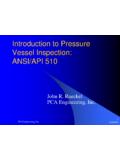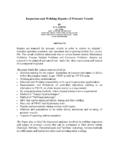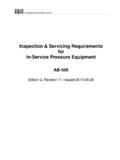Transcription of Safety update: high pressure cylinder inspection …
1 Safety update : high pressure cylinder inspection and testing DNV GL adds acoustic emissions testing to its rule set, making it preferred method for seamless steel gas cylinders' periodic inspection and testing is this the end of periodic hydro testing ? Abstract high pressure gas cylinders (also called tubes) are certified for continued use once they pass their periodic inspection and test. The previously accepted practice for testing the cylinders was the hydrostatic proof test, known as hydro', where water is introduced before it is pressurised to the cylinder 's test pressure , commonly one and a half times the operating pressure .
2 The problems caused by the hydro testing of high pressure gas cylinders in offshore vessels include concerns over Safety ; the long time required to complete the tests; and the expense. It is now possible for a more sophisticated technique to be deployed. Acoustic emission (AE) testing is claimed to be faster, cheaper and safer. Leading testing and certification authority DNV GL is the first classification society to include AE testing in its rule set, aligning it with a new European Standard for seamless gas cylinders and their periodic inspection and testing (EN 16753), which was introduced in 2016 and incorporates the AE method.
3 This paper examines the benefits of AE over hydro testing within the regime of periodic inspections and tests. Introduction DNV GL has recommended the use of acoustic emission (AE) testing for seamless gas cylinders, a move many think will see hydro testing phased out. DNV GL says AE testing is more time-efficient, and it reduces the risk of causing the cylinder to rust. The Integrity Management team at Chesterfield Special Cylinders (CSC IM) states that AE is a modern alternative to hydro testing : safer, faster and cheaper. Fig. 1 AE tests give far more accurate results so issues can be rectified, rather than allowed to damage the cylinder Arnfinn Hansen, Principal Engineer, Offshore Equipment and Diving at DNV GL, is a world-renowned inspection and testing expert whose experience dates back to the 1980s when he conducted tests on cylinders used in space exploration.
4 He says: AE testing uses sensors mounted on the cylinder to listen' for cracks by detecting so-called elastic waves. These types of cylinders can carry up to 3000 litres of water, so not having to fill the cylinder with this volume is more time-efficient, and it reduces the risk of causing the cylinder to rust.. Safer, faster, cheaper CSC IM is at the vanguard of AE testing , having already worked globally for owners and operators such as Saipem, Sealion Shipping and Fugro TSM. CSC IM director, Stephen Butler, cites Safety as a key reason for AE's rise in popularity: We welcome DNV GL's recommendation of AE because hydro testing is less safe, takes too long and is more expensive.
5 Our view is that AE will replace periodic hydro testing , says Butler. AE is safer for several reasons. It does not require the potentially dangerous pressurising of the cylinders to one and a half times the pressure for which they are manufactured, as hydro tests do. And, as AE is a dry test, it does not require the introduction of water into the cylinders, which can be a lengthy and potentially damaging process. Many vessels retain water after the hydro test and this can damage the integrity of the cylinder . Of course, hydro testing also requires the repeated insertion and removal of test fittings which brings the risk of thread damage.
6 It is every owner and operator's responsibility to ensure that every process is safe, valid and delivers the best value. The EN standard which encompasses AE testing fits these demands when it comes to high pressure vessel inspection and testing . Now that AE techniques have been developed - in line with the hi-tech nature of other NDT. techniques - and global authorities such as DNV GL are recommending them, I have no doubt that the hydro test element within periodic inspection and testing will become a thing of the past.. It is predicted that end users of cylinders in new installations will only use AE tests so that water is never deliberately introduced into the system.
7 For older dive systems previously subjected to hydro tests and related cleaning processes, AE tests will assure the end user of the integrity of these aging products by confirming the absence of growing fatigue cracks. Faster Fig. 2 rust caused by water left in cylinder after hydro test Many owners and operators need their gas cylinders inspecting and testing quickly, when their certification is due to lapse. It is believed that AE tests will facilitate this far more easily than hydro testing , simply because the start-to-finish AE project is faster than the hydro test process. HYDRO AE. PROCESS PROCESS.
8 STEPS REQUIRED. remove the cylinders or calculate extra load on . mountings for when water is introduced remove fittings and carry out internal inspection . fit test fittings . fill with water, evacuating all the air . charge to cylinder test pressure (usually around one . and a half-times working pressure ). after monitoring period, remove water . remove test fittings . dry out . apply operational fittings . purge . conduct moisture check . charge with operational gas to AE test pressure , usually . working pressure , while monitoring hope rust bloom has not caught as this will require . resolving with additional shot blasting or acid cleaning.
9 Return cylinders to operation . Steps required for hydro process: 1. remove the cylinders or calculate extra load on mountings for when water is introduced 2. remove fittings and carry out internal inspection 3. fit test fittings 4. fill with water, evacuating all the air 5. charge to cylinder test pressure (usually around one and a half-times working pressure ). 6. after monitoring period, remove water 7. remove test fittings 8. dry out 9. apply operational fittings 10. purge 11. conduct moisture check 12. hope rust bloom has not caught as this will require resolving with additional shot blasting or acid cleaning.
10 Steps required for AE process: 1. remove fittings and carry out internal inspection 2. refit operational fittings 3. charge with operational gas to AE test pressure , usually working pressure , while monitoring 4. return cylinders to operation No matter how much effort is put into drying cylinders after a hydro test, an arduous task in itself, there is often residual water in the vessel and this will have to be removed with a further purging process and, on the following test, there will be a potential need for additional work to clean corrosion. This could require shot blasting, flailing or acid cleaning, which can also leave residual acid in the cylinder , so a further flushing process may have to be used to eliminate this, compounding the drying issue.






